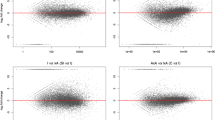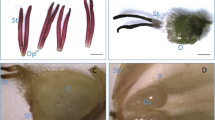Abstract
Almond [Prunus dulcis (Miller) D.A. Webb] exhibits self-incompatibility of the gametophytic type, which is controlled by a locus named S with expression in pistils (S-RNase) and in pollen (SFB protein). Recent studies support the involvement of other unidentified components (named modifier factors) in the incompatibility system of this species. A few proteomic studies have tried to identify modifier factors in Prunus species using comparative proteomics of pollinated pistils. However, there are no studies in which the pollen and un-pollinated pistils from self-incompatible and self-compatible Prunus species are compared. In the present work, IEF and RT-PCR analyses of pistils from two almond selections with the S f haplotype but different incompatibility phenotypes revealed that lack of ribonuclease activity in the self-compatible individual is not due to the absence of Sf-RNase transcripts. To identify the proteins differentially expressed in the pistils and anthers of these selections, which could be candidates for modifier factors, isobaric tags for relative and absolute quantitation and 2D-nano-liquid chromatography–electrospray ionisation tandem mass spectrometry were carried out. After a BLAST search against the UniProtKB/SwissProt database, 23 proteins were identified as differentially expressed in pistils and 17 proteins were identified as differentially expressed in anthers. Grouping these proteins into functional categories revealed that most of the pistil proteins had a metabolic function, followed by proteins with a stress resistance and defence function. In the case of anthers, metabolic proteins together with stress resistance and defence proteins were also predominant, although this time in equal proportion. Moreover, the differentially expressed proteins were associated with particular genes, which were located in the Prunus persica Whole Genome version 1.0. Some of the proteins identified here have been linked to pollen development, to pollen dynamics or to pollen–pistil interactions. These results not only provide proteomic profiles of differential expression in mature pistils and anthers, but could also serve as a reference for other comparative proteomic studies of pollinated pistils in almond and in other species with the same incompatibility system.



Similar content being viewed by others
References
Blackbourn HD, Barker P, Huskisson NS, Battey NH (1992) Properties and partial protein sequence of plant annexins. Plant Physiol 99:864–871
Bošković R, Tobutt KR (1996) Correlation of stylar ribonuclease zymograms with incompatibility alleles in sweet cherry. Euphytica 90:245–250
Bošković R, Tobutt KR, Batlle I, Duval H (1997) Correlation of ribonuclease zymograms and incompatibility genotypes in almond. Euphytica 97:167–176
Bošković R, Tobutt KR, Batlle I, Duval H, Martínez-Gómez P, Gradziel TM (2003) Stylar ribonucleases in almond: correlation with and prediction of incompatibility genotypes. Plant Breed 122:70–76
Bošković RI, Tobutt KR, Ortega E, Sutherland BG, Godini A (2007) Self-(in)compatibility of the almonds P. dulcis and P. webbii: detection and cloning of ‘wild-type S f ’ and new self-compatibility alleles encoding inactive S-RNases. Mol Genet Genomics 278:665–676
Bradford MM (1976) A rapid and sensitive method for the quantitation of microgram quantities of protein utilizing the principle of protein-dye binding. Anal Biochem 72:248–254
Cachi AM, Wünsch A (2011) Characterization and mapping of non-S gametophytic self-compatibility in sweet cherry (Prunus avium L.). J Exp Bot 62:1847–1856
Cao X, Feng J, Wang D, Sun J, Lu X, Liu H (2012) Primary style protein expression in the self-incompatible/self-compatible apricot by the 2D-DIGE technique. Gene 503:110–117
Casado-Vela J, Martínez-Esteso MJ, Rodríguez E, Borrás E, Elortza F, Bru-Martínez R (2010) iTRAQ-based quantitative analysis of protein mixtures with large fold change and dynamic range. Proteomics 10:343–347
Chalivendra SC, López-Casado G, Kumar A, Kassenbrock AR, Royer S, Tovar-Mèndez A, Covey PA, Dempsey LA, Randle AM, Stack SM, Rose JKC, McClure B, Bedinger PA (2012) Developmental onset of reproductive barriers and associated proteome changes in stigma/styles of Solanum pennellii. J Exp Bot 64:265–279
Cruz-García F, Hancok CN, Kim D, McClure B (2005) Stylar glycoproteins bind to S-RNase in vitro. Plant J 42:295–304
Dai S, Li L, Chen T, Chong K, Xue Y, Wang T (2006) Proteomic analyses of Oryza sativa mature pollen reveal novel proteins associated with pollen germination and tube growth. Proteomics 6:2504–2529
Dumas C, Knox RB (1983) Callose and determination of pistil viability and incompatibility. Theor Appl Gen 67:1–10
Felipe AJ (1977) Stadi fenologici del mandorlo. Proceedings of the 3rd GREMPA Colloquium, 3–7 October 1977, Valenzano, Bari, Italy. Edizioni Quadrifoglio, Bari, pp 101–103
Feng J, Chen X, Yuan Z, He T, Zhang L, Wu Y, Liu W, Liang Q (2006) Proteome comparison following self- and across-pollination in self-incompatible apricot (Prunus armeniaca L.). Protein J 25:328–335
Feng JR, Chen XS, Yuan ZH, Zhang LJ, Ci ZJ, Liu XL, Zhang CY (2009) Primary molecular features of self-incompatible and self-compatible F1 seedling from apricot (Prunus armeniaca L.) Katy × Xinshiji. Mol Biol Rep 36:263–272
Fernández i Martí A, Hanada T, Alonso JM, Yamane H, Tao R, Socias i Company R (2010) The almond S f haplotype shows a double expression despite its comprehensive genetic identity. Sci Hortic 125:685–691
Fernández i Martí A, Howad W, Tao R, Alonso JM, Arús P, Socias i Company R (2011) Identification of quantitative trait loci associated with self-compatibility in a Prunus species. Tree Genet Genomes 7:629–639
Franklin-Tong VE (1999) Signaling and the modulation of pollen tube growth. Plant Cell 11:727–738
Gambino G, Perrone I, Gribaudo I (2008) A rapid and effective method for RNA extraction from different tissues of grapevine and other woody plants. Phytochem Anal 19:520–525
Godini A (1975) Il mandorlo in Puglia. Notiziario di Ortoflorofruticoltura 1:11–12
Goldraij A, Kondo K, Lee CB, Hancock CN, Sivaguru M, Vázquez-Santana S, Kim S, Phillips TE, Cruz-García F, McClure B (2006) Compartmentalization of S-RNase and HT-B degradation in self-incompatible Nicotiana. Nature 439:805–810
Grenier J, Potvin C, Trudel J, Asselin A (1999) Some thaumatin-like proteins hydrolyse polymeric β-1,3-glucans. Plant J 19:473–480
Hanada T, Fukuta K, Yamane H, Esumi T, Tao R, Gradziel TM, Dandekar AM, Fernández i Martí A, Alonso JM, Socias i Company R (2009). Cloning and characterization of a self-compatible S f haplotype in almond [Prunus dulcis (Mill.) D.A. Webb. syn. P. amygadalus Batsch] to resolve previous confusion in its S f -RNase sequence. HortScience 44:609–613
Jahnen W, Batterham MP, Clarke AE, Moritz RL, Simpson RJ (1989) Identification, isolation, and N-terminal sequencing of style glycoproteins associated with self-incompatibility in Nicotiana alata. Plant Cell 1:493–499
Jiang YQ, Ma RC (2003) Generation and analysis of expressed sequence tags from almond (Prunus dulcis Mill.) pistils. Sex Plant Reprod 16:197–207
Kodad O, Alonso JM, Fernández i Martí A, Oliveira MM, Socias i Company R (2010) Molecular and physiological identification of new S-alleles associated with self-(in)compatibility in local Spanish almond cultivars. Sci Hortic 123:308–311
Kumar A, McClure B (2010) Pollen–pistil interactions and the endomembrane system. J Exp Bot 61:2001–2013
Liu W, Fan J, Li J, Song Y, Li Q, Zhang Y, Xue Y (2014) SCFSLF-mediated cytosolic degradation of S-RNase is required for cross-pollen compatibility in S-RNase-based self-incompatibility in Petunia hybrida. Front Genet 5:228. doi:10.3389/fgene.2014.00228
Martinez-García PJ, Mañas F, López P, Dicenta F, Ortega E (2011) Molecular and phenotypic characterization of the S-locus and determination of flowering time in new ‘Marcona’ and ‘Desmayo Largueta’-type almond (Prunus dulcis) selections. Euphytica 177:67–78
Martínez-García PJ, Gómez EM, Casado-Vela J, Elortza F, Dicenta F, Ortega E (2015) Differential protein expression in compatible and incompatible pollen–pistil interactions in almond [Prunus dulcis (Miller) D.A. Webb] by 2D-DIGE and HPLC-MS/MS. J Hortic Sci Biotech 90:71–77
Mayfield JA, Fiebig A, Johnstone SE, Preuss D (2001) Gene families from the Arabidopsis thaliana pollen coat proteome. Science 292:2482–2485
McClure BA, Gray JE, Anderson MA, Clarke AE (1990) Self-incompatibility in Nicotiana alata involves degradation of pollen rRNA. Nature 347:757–760
McClure BA, Mou B, Canevascini S, Bernatzky R (1999) A small asparagine-rich protein required for S-allele-specific pollen rejection in Nicotiana. PNAS 96:13548–13553
McClure BA, Cruz-García F, Beecher BS, Sulaman W (2000) Factors affecting inter- and intra-specific pollen rejection in Nicotiana. Ann Bot 85:113–123
Ortega E, Dicenta F (2003) Inheritance of self-compatibility in almond: breeding strategies to assure self-compatibility in the progeny. Theor Appl Genet 106:904–911
Ortega E, Dicenta F (2004) Suitability of four different methods to identify self-compatible seedlings in an almond breeding programme. J Hortic Sci Biotechnol 79:747–753
Ortega E, Martínez-García PJ, Dicenta F, Egea J (2010) Disruption of endosperm development: an inbreeding effect in almond (Prunus dulcis). Sex Plant Reprod 23:135–140
Sassa H, Hirano H (1998) Style-specific and developmentally regulated accumulation of a glycosylated thaumatin/PR5-like protein in Japanese pear (Pyrus serotina Rehd.). Planta 205:514–521
Sonneveld T, Tobutt KR, Vaughan SP, Robbins TP (2005) Loss of pollen-S function in two self-compatible selections of Prunus avium is associated with deletion/mutation of an S haplotype-specific F-box gene. Plant Cell 17:37–51
Stone BA, Clarke AE (1992) Chemistry and physiology of higher plant 1,3-β-glucanase (callose). In: Stone BA, Clarke AE (eds) Chemistry and biology of (1-3)-β-glucans. La Trope University Press, Victoria, pp 365–429
Suen DF, Wu SSH, Chang HC, Dhugga KS, Huang AHC (2003) Cell wall reactive proteins in the coat and wall of maize pollen. J Biol Chem 278:43672–43681
Tao R, Iezzoni AF (2010) The S-RNase based gametophytic self-incompatibility system in Prunus exhibits distinct genetic and molecular features. Sci Hortic 124:423–433
Tao R, Yamane H, Sassa H, Mori H, Gradziel TM, Dandekar AM, Sugiura A (1997) Identification of stylar RNases associated with gametophytic self-incompatibility in almond (Prunus dulcis). Plant Cell Physiol 38:304–311
Taylor LP, Jorgensen R (1992) Conditional male fertility in chalcone synthase-deficient Petunia. J Heredity 83:11–17
Uchida S, Sassa H, Takenaka S, Sakakibara Y, Suiko M, Kunitake H (2012) Identification of self-incompatibility related proteins in the pistil of Japanese pear [Pyrus pyrifolia (Burm. F.)] by proteome analysis. Plant Omics J 5:320–325
Updegraff EP, Zhao F, Preuss D (2009) The extracellular lipase EXL4 is required for efficient hydration of Arabidopsis pollen. Sex Plant Reprod 22:197–204
Ushijima K, Sassa H, Dandekar AM, Gradziel TM, Tao R, Hirano H (2003) Structural and transcriptional analysis of self-incompatibility (S) locus of almond (Prunus dulcis): identification of a pollen-expressed F-box gene with haplotype-specific polymorphism. Plant Cell 15:771–781
Verde I, Abbott AG, Scalabrin S, Jung S, Shu S, Marroni F, Zhebentyayeva T, Dettori MT, Grimwood J, Cattonaro F et al (2013) The high-quality draft genome of peach (Prunus persica) identifies unique patterns of genetic diversity, domestication and genome evolution. Nat Genet 45:487–494
Vilanova S, Badenes ML, Burgos L, Martínez-Calvo J, Llácer G, Romero C (2006) Self-compatibility of two apricot selections is associated with two pollen-part mutations of different nature. Plant Physiol 142:629–641
Wang L, Peng H, Ge T, Liu T, Hou X, Li Y (2014) Identification of differentially accumulating pistil proteins associated with self-incompatibility of non-heading Chinese cabbage. Plant Biol 16:49–57
Yang S, Terachi T, Yamagishi H (2008) Inhibition of chalcone synthase expression in anthers of Raphanus sativus with Ogura male sterile cytoplasm. Ann Bot 102:483–489
Zhang SL, Hiratsuka S (1999) Variations on S-protein levels in styles of Japanese pears and the expression of self-incompatibility. J Jpn Soc Hortic Sci 68:911–918
Zuriaga E, Muñoz-Sanz JV, Molina L, Gisbert AD, Badenes ML, Romero C (2013) An S-Locus independent pollen factor confers self-compatibility in ‘Katy’ apricot. PLoS ONE 8:e53947
Acknowledgments
This work has been financially supported by the Project ‘Mejora Genética del Almendro’ funded by the Spanish ministry MINECO (Ministerio de Economía y Competitividad). The authors wish to thank Fernando Mañas from ITAP for providing shoots from ITAP-1 selection and also Ansley Evans for revision of the English in the manuscript. Eva María Gómez acknowledges the receipt of a FPI doctoral fellowship from the Spanish ‘Ministerio de Ciencia e Innovación.’
Author information
Authors and Affiliations
Corresponding author
Rights and permissions
About this article
Cite this article
Gómez, E.M., Dicenta, F., Martínez-García, P.J. et al. iTRAQ-based quantitative proteomic analysis of pistils and anthers from self-incompatible and self-compatible almonds with the S f haplotype. Mol Breeding 35, 120 (2015). https://doi.org/10.1007/s11032-015-0314-5
Received:
Accepted:
Published:
DOI: https://doi.org/10.1007/s11032-015-0314-5




